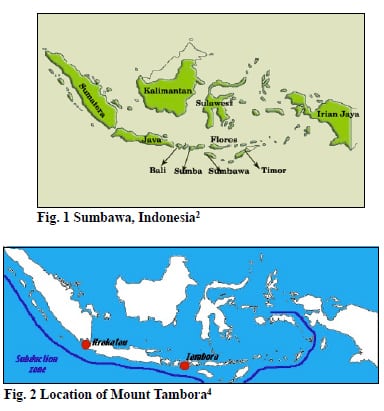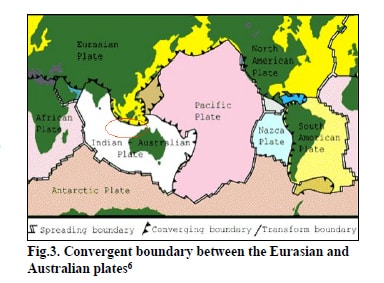Mount Tambora, is an active stratovolcano famous for its eruption in 1815 which was considered one of the most explosive volcanic eruptions in Earthʼs history.
A stratovolcano is a volcano characterized by its steepness and periodic explosive eruptions and quiet eruptions. It is also known as a composite volcano because it is composed of layers of hardened lava, tephra, pumice, and volcanic ash.
The lava that flows from stratovolcanos is typically made of magma with high levels of silica which causes it to have a high viscosity, and thus, not flow very far. Mount Tambora is located on the island of Sumbawa, Indonesia (Fig. 1). The island is in between tectonic plates, which creates a subduction zone beneath Tambora (Fig. 2).
1815 Explosion
In 1815, Mount Tambora famously erupted, with the explosion being a 7 on the volcanic explosivity index, which easily made it the highest-rated eruption since Lake Taupo in 1815. It is estimated that the eruption produced 160 cubic kilometers of magma. It is also estimated that at least 11 000 – 12 000 people died as a result of the actual eruption, while the total death toll is around 71 000, most of whom died from the consequences of the eruption. The magnitude of the 1815 eruption caused the worst famine in the 19th century due to the death of most agriculture and livestock in the northern hemisphere.
Subduction Zone
The reason for the explosive events of Mount Tambora all comes down to the concept of plate tectonics. Many of the islands of Indonesia are situated on the convergent plate boundary of the Eurasian and Australian plates (Fig.2). A convergent boundary is one where two plates are moving towards one another. In the case of the Australian and Eurasian plates, this creates a subduction zone, where the Australian plate slides beneath the Eurasian plate which creates a deep trench as well as a region of compression.
Volcano Formation
The Australian plate which is sliding below the Eurasian plate is saturated with water which aids in melting the mantle wedge above the Australian plate creating Fig. 3. The convergent boundary between the Eurasian and Australian plates magma.
Often that magma cools and a volcano does not form. However, when the magma reaches the surface, a volcano is formed. The explosivity of the volcano is generally determined by the composition of the magma which changes as it moves upward through the continental crust and encounters different rocks with different minerals in them.
This process of modifying the magma is called magma mixing and ends in magma that is extremely different from the original magma. If the magma reaches the surface of the earth it is guaranteed to be cooler, more volatile-rich, and more silica-rich which will make it more viscous and explosive.
Prior to 1815
Before the 1815 eruption, there are three recorded eruptions dated using the radiocarbon method. All three of these eruptions have a relatively unknown magnitude. The three dates of these eruptions were 3910BC, 3050BC, and 740AD. All of them consisted of a central vent eruption, and explosive eruption, while the first two also had pyroclastic flow. Given these dates of eruption, the three major dormancy periods prior to 1815 were approximately 860 years, 3790 years, and 1075 years.
Post 1815
Mount Tambora is still considered an active volcano today, and since its 1815 eruption, there have been three dates of recorded activity. In both 1819 and 1880 there was an eruption rated a 2 on the volcanic explosivity index (VEI). The second of these eruptions involved lava flow and lava dome extrusion, while the first only had a central vent eruption and an explosive eruption.
The third and latest eruption occurred in 1967 which was rated a 0 on the VEI and involved a central vent eruption and lava flow. Given these dates of eruption, the three major dormancy periods after 1815 were approximately 4 years, 61 years, and 87 years.
Main Event
By April 10th, 1815, the eruptions had increased enormously in magnitude and flames emerged from the volcano reaching 40km high. The entirety of Mount Tambora was covered in flowing liquid fire. Additionally, pumice stones rained down with diameters as large as 20cm. Pyroclastic flows reached the waterʼs edge on all sides of the 60km wide volcanic peninsula and the eruption column. Following this devastating eruption, there were smaller explosions, declining in intensity over the next few months.
The recorded date of the final eruption is July 15 1815. In order to understand the materials ejected from the volcano, it is necessary to understand the different types of volcanic materials: lava flows, pyroclastic flows, and volcanic gases. Lava flows depend on the silica content, metal oxides, and the temperature of the lava.
A pyroclastic flow is a combination of gases, ash, and rock that flow down the volcano at extremely high speeds (ex. 100km/hr) at extremely high temperatures (several hundred degrees Celsius). Volcanic gases consist of water, carbon dioxide, sulfur dioxide, and hydrogen sulfide and may be a part of magma. Over 160 cubic kilometres of magma was ejected from the volcano, which is the equivalent to 16000 Hiroshima bombs10, along with two hundred million tonnes of sulphur dioxide.
The height of the eruption column reached the stratosphere, which is at an altitude of approximately 43km. Some of the coarser ash particles fell to the ground in the next few weeks, but the finer ash particles remained in the air from anywhere of a few months to several years.
Explosivity and Fatalities
On the volcanic explosivity index, the 1815 blast was a 7, which is classified as super-colossal. The explosion caused tsunamis with heights up to 4-5m and extensive land and property damage. The entire village of Tambora was completely wiped out. It is estimated that at least 10000-11000 people were directly incinerated from the magma, while more people lost their lives from the tsunamiʼs and whirlwind that followed the explosion.
The leading cause of death however, was indirectly caused by the blast. Thick ash from the volcano covered land and destroyed all crops, livestock, and clean water. From famine came disease which was also responsible for many deaths. The total number of fatalities is estimated at around 71000 people.
Global Cooling
The eruption had a vast variety of effects on the globe, most of which were negative. The effect of the largest magnitude is what historians refer to as “The Year Without a Summer” which refers to a global cooling that followed the eruption. It was not until 1920 that an explanation for global cooling was established.
William J Humphreys, who was an American climatologist proposed that the eruption was strong enough to blow ash and gases into the stratosphere. Once in the stratosphere, winds blew all of the particles and gas all over the world in the span of the next year. This dust cloud created a screen that reflected the sunʼs heat. Evidence of this could be seen in the brown and red snow that fell in Hungary and Italy, which was thought to be due to the volcanic ash in the atmosphere.
Global Population Effects
Effects of “The Year Without a Summer” could be seen all over the northern hemisphere. In North America, New England and Maine were experiencing frost on 6 June, July, and August that was kill all of the crops. In France and Germany, grape and corn crops were almost entirely wiped out. In China, rice production was at an all-time low and summer snowfall was reported in a variety of places.
The overall effect of these crop failures was widespread famine, especially in Europe, and epidemic outbreaks. It is important to note that prior to the eruption, Europe was still recovering from the Napoleonic wars. This caused the eruption to have a significantly larger effect because many countries were already in a fragile condition. The approximate Europe fatality was around 200 000, indirectly due to the eruption which caused the famine, and also a typhus epidemic that occurred in Ireland.
Cultural and Demographic Effects
This time of global cooling also proved to affect cultural aspects of the globe. Vibrant sunsets could be seen frequently all over the world following the eruption, due to the optical illusion created by the fine ash particles in the air. It is thought that the effects of these sunsets can be seen in the paintings of J.M.W Turner. In addition to paintings, it is thought that the novel Frankenstein is a result of global cooling.
Mary Shelley is thought to have been part of a group that stayed indoors during the rainfall. To entertain themselves, they had a contest of whom could write the scariest story, and thus Frankenstein emerged. The crop failures also encouraged the movement of many farmers from New England to move west in search of a better climate and crop conditions. From New England, many people moved to the area that is now known as Western and Central New York, and the Upper Midwest. Population drops were as large as 10 000- 15 000 people (Vermont).
Mount Tambora Today
Mount Tambora is still considered active today, and recently in 2011, the alert level was raised to a level III because of increasing reported activity. Itʼs last eruption was in 1967 and was very small with a 0 rating on the volcanic explosivity index. Tourists regularly visit Mount Tambora and sometimes climb it, although the climb is not easy, and requires prior mountain climbing experience and excellent physical condition and endurance.
Since the eruption, the population in the surrounding area has increasingly grown with Indonesiaʼs population reaching 222 million by 2006. An eruption of the magnitude of 1815 would cause much more devastation due to the increased population, and thus the volcanic activity of all volcanoes, including Mount Tambora, is closely monitored.



THANK YOU
this saved my life I was able to finish my project with it thanks
same 🙂
same :))
i have never experianced a volcano
I was there when it happened….
That was more that 200 years ago.
hes joking
wow, you must be pretty old
very helpful
really helpful
can you please tell me when this article was published, and when it was released to the public?
Helpful!
References???
i got my project done with this
You do not provide the right information!
YESSS! Love it!
Nice info
Awesome
Thank you very much
Hi, thanks for this!
This… is… AWESOME! It helped me so much on my school project. This is a life saver.
This saved my life. I needed something like this so badly for a school project.
THAT’S GREAT! THANKS
Thank you for the help
hi, excellent work!
this did not answer my question 🙁
wow thanks
this helped a lot thanks
is ” cold summer ” one effect of Tambora eruption?
yes
Thank you this is very helpful I bet for sure i’ll get an A on my project !
Most informative text from it. Learnt a lot as I needed it for a school project. Thanks 🙂
thanks, you helped me finish my project.
Thanks a lot!!